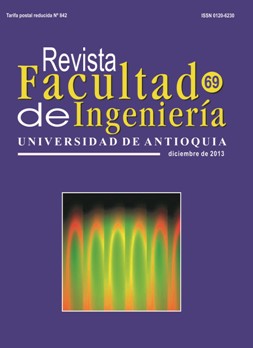Computational Intelligence Techniques Applied to Coagulant Estimation Models in Water Purification Process
DOI:
https://doi.org/10.17533/udea.redin.18150Keywords:
coagulant dosing, artificial neural networks, fuzzy logic sugeno type, fuzzy logic Mamdani type, ANFIS, water purificationAbstract
Four coagulant estimation models in water purification process are presented. For its developing computational intelligence techniques are used, which include neural networks, fuzzy logic (Sugeno and Mamdani type) and ANFIS structures. The methodology described is based on the operator's experience extraction from operational historical data (in neural network, fuzzy logic Sugeno type and ANFIS case), and the linguistic information given by an experimented plant operator (in fuzzy logic Mamdani type case). According to the reached results, by applying some of this models in a control system strategy, could be possible overcome some of the current limitations found in the most widely used techniques for coagulant dosing in water purification plants; jar tests and streaming current detector.
Downloads
References
A.Mirsepassi, B. Carthers, H. Dharmappa. “Application of Artificial Neural Networks to the Real Time Operation of Water Treatment Plants”. Proceedings of the IEEEInternational Conference on Neural Networks. Vol. 1. 1995.pp. 516-521.
N. Valentin, T. Denoux, F. Fotoohi. “An Hybrid Neural Network Based System for Optimization of Coagulant Dosing in a Water Treatment Plant”. International Joint Conference on Neural Networks.Vol. 5. 1999. pp. 3380-3385.
B. Lennox, G. Montague, A. Frith, C. Gent, V. Bevan.“Industrial application of neural networks – An investigation”. Journal of Process Control. Vol 11. 2001. pp. 497-507. DOI: https://doi.org/10.1016/S0959-1524(00)00027-5
H. Maeir, N. Morgan, W. Chow. “Use of artificial neural networks for predicting optimal alum doses and treated water quality parameters”.Environmental Modelling & Software. Vol. 19. 2004. pp. 485-494. DOI: https://doi.org/10.1016/S1364-8152(03)00163-4
G. Wu, S. Lo. “Predicting real-time coagulant dosage in water treatment by artificial neural networks and adaptive network-based fuzzy inference system”. Engineering Applications of Artificial Intelligence. Vol. 21. 2008. pp. 1189-1195. DOI: https://doi.org/10.1016/j.engappai.2008.03.015
X. Yi, Q. Wei, C. Li. The BP network model for the control of the coagulation and the filter backwashing system. The Second International Conference on Bioinformatics and Biomedical Engineering. Shangai, China. 2008. pp. 1518-1521. DOI: https://doi.org/10.1109/ICBBE.2008.709
B. Lamrini, A. Benhammou, A. Karama, M. Le Lann. “A Neural Network System for modeling of coagulant dosage used in drinking water treatment”. Adaptative and Natural Computing Algorithms. Part I. 2005. pp. 96-99. DOI: https://doi.org/10.1007/3-211-27389-1_23
Z. Song, Y. Zhao, X. Song, Ch. Liu. Research on Prediction Model of Optimal Coagulant Dosage in Water Purifying Plant Based on Neural Networks. International Colloquium on Computing, Communication, Control and Management ISECS. Sanya, China. 2009. pp. 258-261. DOI: https://doi.org/10.1109/CCCM.2009.5267728
E. Nham, T. Ham, K. Woo, C. Kim, J. Ryu. Optimization of coagulant dosing process in water purification system. Proceedings of the 36th SICE Annual Conference, International Session Papers. Tokushima, China. 1997. pp. 1105-1109.
M. Duque, E. Giraldo, A. Martínez, A. Gauthier, J. Villa. “El Uso de la Lógica Difusa para la Potabilización del Agua”. Revista de Ingeniería de la Universidad de los Andes. No. 12. 2000. pp. 31-35. DOI: https://doi.org/10.16924/riua.v0i12.559
H. Bai. A Fuzzy Logic Based Coagulant Real Time Control Squeme for Water Purification Systems. Proceedings of the IEEE International Conference on Mechatronics and Automation. Changchun, China. 2009. pp. 2123-2127. DOI: https://doi.org/10.1109/ICMA.2009.5246439
M. Chun, K. Kwak, J. Ryu.“Application of ANFIS for Coagulant Dosing Process in a Water Purification Plant”. Fuzzy Systems Conference Proceedings. Vol 3. 1999. pp. 1743-1748.
I. Ben. Outlier Detection. Ed. Kluwer Academic Publishers Dordrecht, Netherlands Available on: Consultado en Julio de 2010.www.eng.tau. ac.il/~bengal/outlier.pdf Accessed: july 2010.
D. Joo, D. Choi, H. Park. “The effects of data preprocessing in the determination of coagulant dosing rate”. Wat. Res. Vol. 34. 2000. pp. 3295-3302. DOI: https://doi.org/10.1016/S0043-1354(00)00067-1
M. Santos, A. Monteiro, J. Simeao. Visualization of geospatial data by component planes and U- Matrix. Disponible en: www.geoinfo.info/geoinfo2004/ papers/6419.pdf. Consultado en Julio 2010.
S. Chiu. “Selecting Input Variables for Fuzzy Models”. Journal of Intelligent & Fuzzy Systems. Vol. 4. 1996. pp. 243-256. DOI: https://doi.org/10.3233/IFS-1996-4401
G. Bloch, T. Denouex. “Neural Networks for Process Control and Optimization: Two Industrial Applications”. ISA Transactions. Vol 42. 2003. pp. 39-51. DOI: https://doi.org/10.1016/S0019-0578(07)60112-8
D. Kaur, D. Baumgartner. A comparative Analysis of Neuro-Fuzzy and Grammatical Evolution models for simulating Field-Effect Transistors. World Congress on Computer Science and Information Engineering. Toledo, USA. Vol. 5. 2009. pp. 179-183. DOI: https://doi.org/10.1109/CSIE.2009.720
S. Chiu. Extracting Fuzzy Rules from Data for Function Approximation and Pattern Classification. Disponible en: http://chius.homestead.com/files/ExtractRulesFromData.pdf. Consultado en Julio 2010.
U. Kayman, M. Setnes. Extended Fuzzy Clustering Algorithms. Disponible en: http://publishing.eur.nl/ir/repub/asset/57/erimrs20001123094510.pdf. Consultado en Julio 2010.
W. Zhang, H. Hu, W. Liu. Rules Extraction of Interval Type-2 Fuzzy Logic System based on Fuzzy c-Means Clustering. 4th International Conference on Fuzzy Systems and Knowledge Discovery. Haikou, China. Vol. 2. 2007. pp. 256-260. DOI: https://doi.org/10.1109/FSKD.2007.503
Downloads
Published
How to Cite
Issue
Section
License
Copyright (c) 2018 Revista Facultad de Ingeniería

This work is licensed under a Creative Commons Attribution-NonCommercial-ShareAlike 4.0 International License.
Revista Facultad de Ingeniería, Universidad de Antioquia is licensed under the Creative Commons Attribution BY-NC-SA 4.0 license. https://creativecommons.org/licenses/by-nc-sa/4.0/deed.en
You are free to:
Share — copy and redistribute the material in any medium or format
Adapt — remix, transform, and build upon the material
Under the following terms:
Attribution — You must give appropriate credit, provide a link to the license, and indicate if changes were made. You may do so in any reasonable manner, but not in any way that suggests the licensor endorses you or your use.
NonCommercial — You may not use the material for commercial purposes.
ShareAlike — If you remix, transform, or build upon the material, you must distribute your contributions under the same license as the original.
The material published in the journal can be distributed, copied and exhibited by third parties if the respective credits are given to the journal. No commercial benefit can be obtained and derivative works must be under the same license terms as the original work.










 Twitter
Twitter